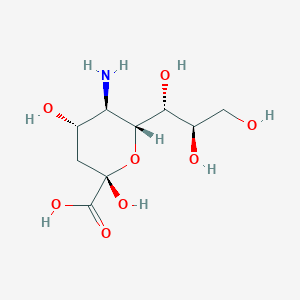| Full List of Protein(s) Regulating This Metabolite |
| Sodium/anion cotransporter (SAC) |
|---|
| Sialin (HP59) |
Click to Show/Hide the Full List of Regulating Pair(s): 2 Pair(s)
|
| Detailed Information |
Protein Info
 click to show the details of this protein click to show the details of this protein
|
| Regulating Pair (1) |
Experim Info
 click to show the details of experiment for validating this pair click to show the details of experiment for validating this pair
|
[1] |
| Introduced Variation |
Mutation (K136E) of SLC17A5 |
| Induced Change |
Neuraminic acid concentration: decrease (FC = 0.50) |
| Summary |
Introduced Variation

 Induced Change
Induced Change

|
| Disease Status |
Lysosomal storage diseases [ICD-11: 5C56]
|
| Details |
It is reported that mutation (K136E) of SLC17A5 leads to the decrease of neuraminic acid levels compared with control group. |
| Regulating Pair (2) |
Experim Info
 click to show the details of experiment for validating this pair click to show the details of experiment for validating this pair
|
[1] |
| Introduced Variation |
Mutation (R39C) of SLC17A5 |
| Induced Change |
Neuraminic acid concentration: decrease (FC = 0.68) |
| Summary |
Introduced Variation

 Induced Change
Induced Change

|
| Disease Status |
Lysosomal storage diseases [ICD-11: 5C56]
|
| Details |
It is reported that mutation (R39C) of SLC17A5 leads to the decrease of neuraminic acid levels compared with control group. |
|
|
|
|
|
|
|
 click to show the details of this protein
click to show the details of this protein
 click to show the details of experiment for validating this pair
click to show the details of experiment for validating this pair
 click to show the details of experiment for validating this pair
click to show the details of experiment for validating this pair

